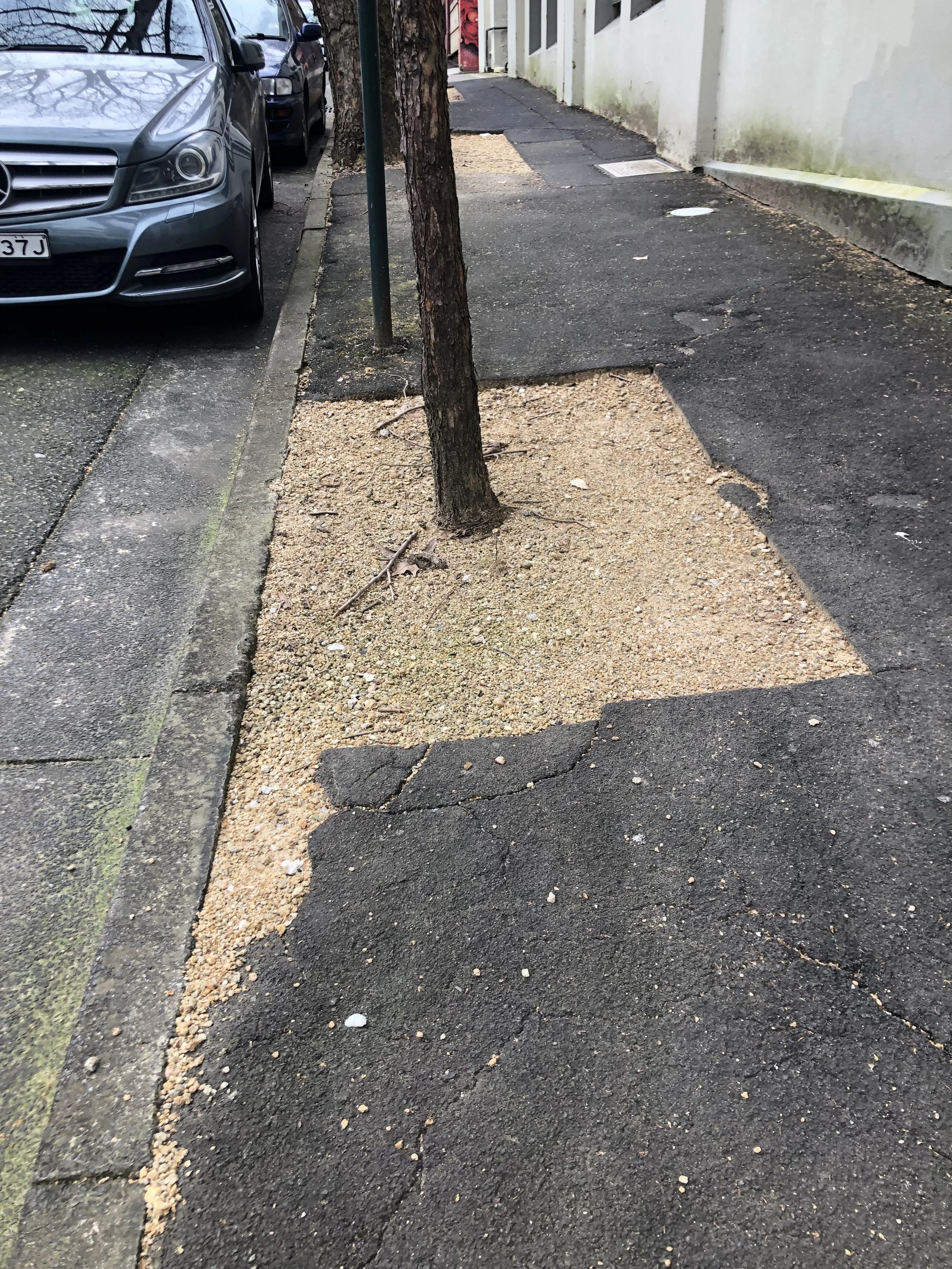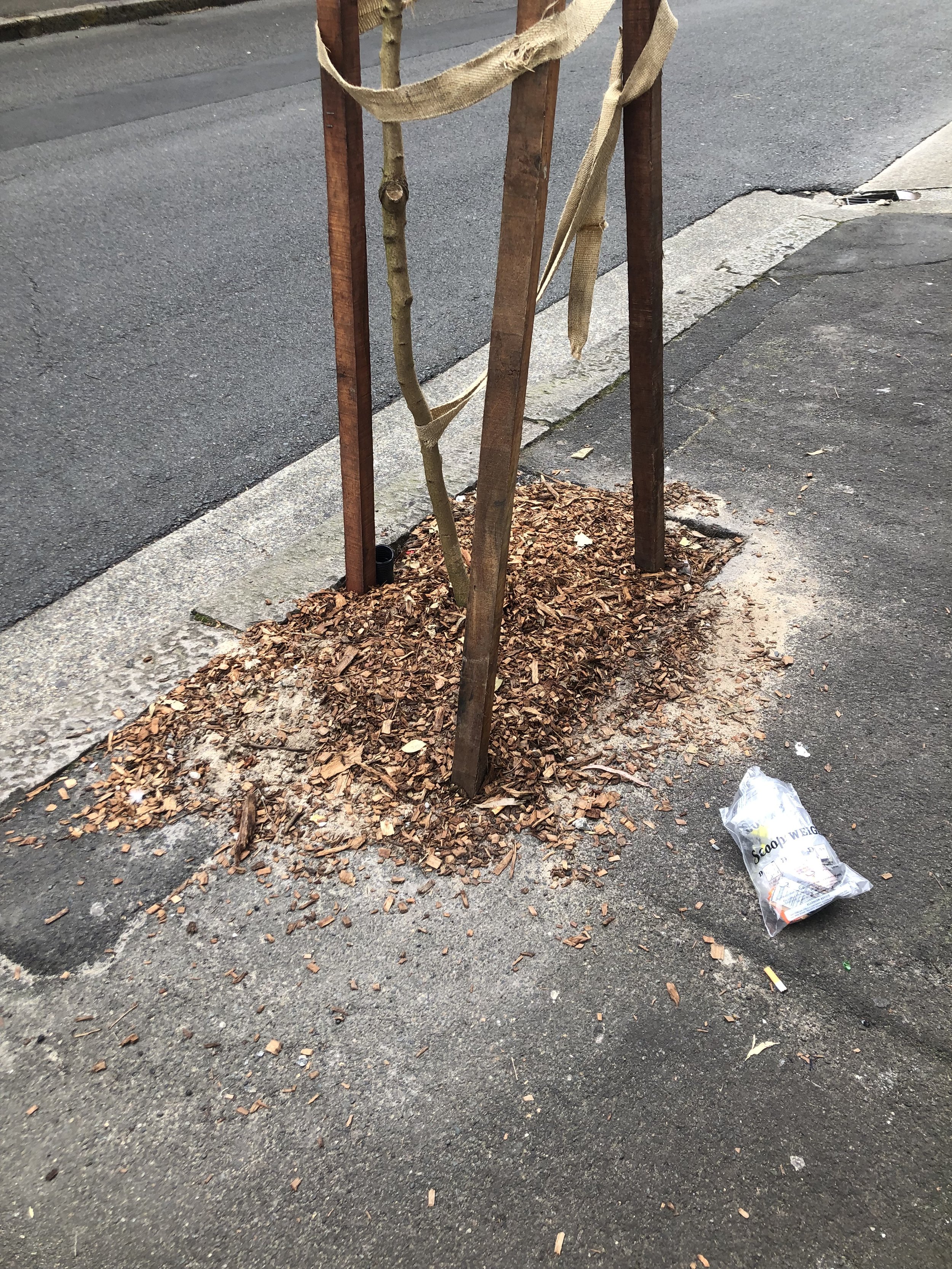• A typical street tree planted so that it is denied rain from the kerb and footpath
City trees grow faster when they get the rain from the street down to their roots.
Let’s have a look at what’s typically going on for trees in streets and some solutions to help trees grow faster by getting them more rain.
On 5 April 2022 the UN and IPCC reported that unless new climate pollution is nil by 2025 there is no potential to avoid climate collapse. The U.N.’s April 2022 report said:
“In the scenarios we assessed, limiting warming to around 1.5°C (2.7°F) requires global greenhouse gas emissions to peak before 2025 at the latest, and be reduced by 43 per cent by 2030; at the same time, methane would also need to be reduced by about a third. Even if we do this, it is almost inevitable that we will temporarily exceed this temperature threshold but could return to C below it by the end of the century.
“It’s now or never, if we want to limit global warming to 1.5°C (2.7°F)…Without immediate and deep emissions reductions across all sectors, it will be impossible.”
Street trees can reduce high temperatures due to shade and transpiration and, in turn, reduce the use of air conditioning and polluting energy.
In Chippendale streets where there is interlocking canopy the streets have been recorded in a research project I conducted for the NSW EPA as over 10 degrees cooler than sunlit streets; the shaded streets were less than 30 degrees while the unshaded streets were over 40 degrees.
City street tree planting practice typically prevents trees being passively irrigated by rainfall, creates runoff of gravel and dirt from around the tree and, where I live in Chippendale, Sydney, that goes into where the fish live in Sydney Harbour at Blackwattle Bay.
The soil trees are planted into are, according to the Sydney Council 2011 Master Tree Plan, “usually highly altered, topsoils may be missing, surfaces paved, service backfilling, lack of drainage, and altered chemistry all affecting the optimum growing conditions”, p B3, 2011 plan.
• Trees in Shepherd Street, Chippendale, all denied rain water
• Trees planted in Knox Street, Chippendale in July 2022
Photos above, taken in August 2022, show the impervious, compacted gravel or crusher dust around trees in Rose and Shepherd Streets, Chippendale, with tell-tale sediment running off on the downhill sides, and no diversion or absorption of rain water to passively irrigate the tree.
Recent plantings in Chippendale have used mulch instead of compacted dust but the mulch is being washed away due to the planting design which puts the mulch on the same level as or higher than the surrounding hard pavement.
To cool the city and meet the UN timetable of ending new pollution by 2025, an emergency program of retrofitting passive drainage to irrigate existing trees should begin in 2022.
The solutions to increase tree growth for both existing and new trees include:
1. Install geofabric covered agricultural drainage pipe 150mm below ground level on all four sides of the tree pit;
2. To provide temporary water holding capacity, lower the ground level 150mm below surrounding pavement and put mulch above up to no higher than 25 mm below pavement level;
3. To harvest rainwater and direct it to the tree cut or bore a hole in the kerb with a large scale mesh in the vertical face of the kerb to exclude rubbish and angled downwards at 30 degrees and connected to a geofabric covered agricultural drainage pipe to irrigate the tree to a depth of at least 350mm (when the pipe is full in heavy rain the pipe will fill and rain will continue down the kerb);
4. Place metal grills over tree planting beds to prevent soil compacting from foot traffic.
• A draingarden to divert rain from the kerb to grow a healthier, faster-growing tree and a garden at the same time
The diversion of rain from the kerb using a hole drilled through the vertical face of the kerb so as to irrigate a tree was done as part of the street cooling project for the EPA; that’s shown in the photo above. The tree was invigorated and the flowering grass below the grill provided a welcome and attractive break to the pavement. (Plans approved by the then Marrickville Council are available upon request.)
Fortunately, some councils (Queensland, mainly) are using a range of designs to keep rainwater where it falls for trees and there’s a manual on Water Wise Street Tree Planting. Designs in the manual show what can be done to passively irrigate street trees, such as these, below.
• Diverting rain from the kerb to the tree
• Another way to divert water from the kerb to the tree
• Yet more ways to divert rain water to grow trees
More diverse tree types – how and why:
Sydney City Council’s street tree masterplan 2011 advocates single species trees for a street or precinct for “consistency and visual uniformity”, not for beauty, or to sustain habitat or wildlife.
The planting of the same species trees, without diversity, has created boring streets. It’s caused the dramatic increase in the introduced pest and predator Indian Myna birds and the loss of several bird and insect species in Chippendale such as the Willy Wagtail, and other small birds. (We may buy traps for Indian Myna birds here.)
• Family of tawny frogmouths in trees in Peace Park, Chippendale; this is mum n dad and the new baby in November 2021 in trees near Peace Park, Chippendale
Presently there is a family of tawny frogmouths, from the nightjar family, in the trees in Peace Park and they are much-loved by our community.
I’ve made a submission to Sydney City Council to make the existing and newly planted street trees self-irrigating, and to protect the Tawny Frogmouths in the park near me, Peace Park. I’ve asked for more diverse trees instead of one type of tree for an area, street or precinct, and for dense bushes to be planted to provide a refuge and safe habitat for small birds.
The Council is updating its 2011 Tree Master Plan so my fingers are crossed the update will change the plan to sustain and grow the numbers of birds, insects, Tawny Mouthed Nightjars.
It can do this by planting more diverse trees and make it so all the trees self-irrigate and get more water and do that in the next few years as the U.N. and IPCC have said is the time remaining to prevent climate collapse.
Michael









